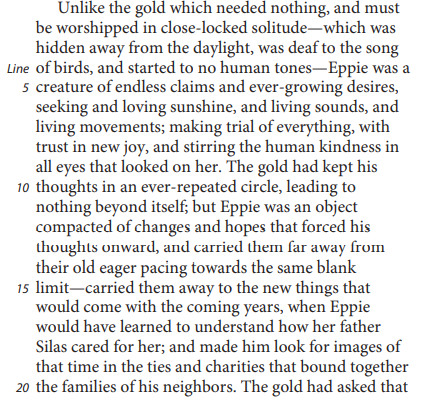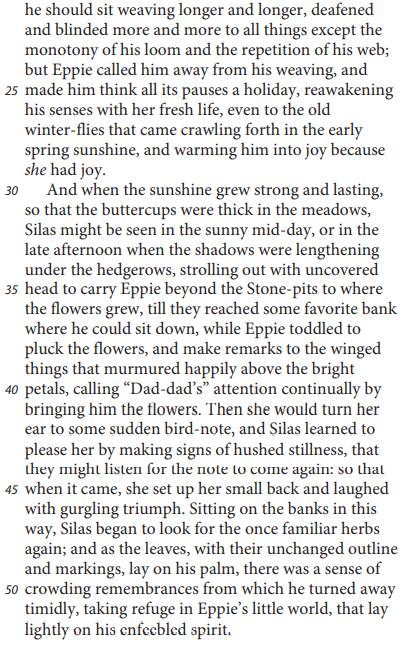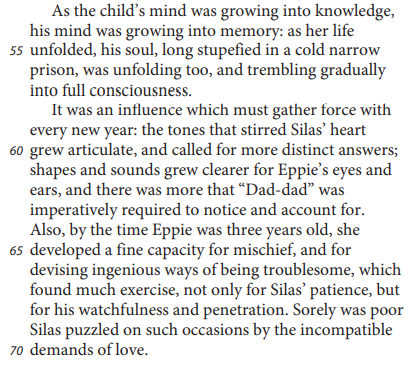SAT (Scholastic Assessment Test) is a standard test, used for taking admission to undergraduate programs of universities or colleges of the United States. SAT is developed and published by the College Board, an organization in the United States, administered by the Educational Testing Service. In this article of AKVTutorials, you will get SAT Reading Practice Test 31 | SAT 2024 Online Tutor AMBiPi.
SAT Reading Practice Passage
This passage is adapted from George Eliot, Silas Marner. Originally published in 1861. Silas was a weaver and a notorious miser, but then the gold he had hoarded was stolen. Shortly after, Silas adopted a young child, Eppie, the daughter of an impoverished woman who had died suddenly.



SAT Reading Comprehension Practice Test Questions
SAT Practice Test 31 Question No 1
Which choice best describes a major theme of the passage?
Option A: The corrupting influence of a materialistic society
Option B: The moral purity of young children
Option C: The bittersweet brevity of childhood naïveté
Option D: The restorative power of parental love
SAT Practice Test 31 Answer No 1
Show/Hide Answer
Option D :
The final sentence of the first paragraph makes clear that before adopting his daughter, the weaver Silas was greedy for gold and chained to his work, “deafened and blinded more and more to all things except the monotony of his loom.” But after adopting Eppie, Silas became more interested in life outside his job: “Eppie called him away from his weaving, and made him think all its pauses a holiday, reawakening his senses with her fresh life.” A major theme of the passage can be seen in this transformation, as it represents how loving a child can improve or change a parent’s life.
Choice A is incorrect because even if the passage implies that Silas was too materialistic before his daughter arrived in his life, his greediness was a personal characteristic only, not a societal one; whether the society Silas lives in is overly materialistic is never addressed. Choice B is incorrect because even if the passage represents the “moral purity” of children, it does so only indirectly and not as a major theme. Choice C is incorrect because the passage addresses childhood enthusiasm and curiosity more than “naïveté” and never discusses the length or “brevity” of that naïveté.
SAT Practice Test 31 Question No 2
As compared with Silas’s gold, Eppie is portrayed as having more
Option A: vitality.
Option B: durability.
Option C: protection.
Option D: self-sufficiency.
SAT Practice Test 31 Answer No 2
Show/Hide Answer
Option A :
The first sentence of the first paragraph notes that “Unlike the gold . . . Eppie was a creature of endless claims and ever-growing desires, seeking and loving the sunshine, and living sounds, and living movements; making trial of everything, with trust in new joy, and stirring the human kindness in all eyes that looked on her.” These lines make clear that in contrast to Silas’s gold, his new daughter is vibrant and alive.
Choices B, C, and D are incorrect because the lines from the first paragraph cited above reveal Eppie’s interest in “living sounds” and “living movements” and thus characterize her vitality in comparison to the gold, rather than her durability, protection, or self-sufficiency.
SAT Practice Test 31 Question No 3
Which statement best describes a technique the narrator uses to represent Silas’s character before he adopted Eppie?
Option A: The narrator emphasizes Silas’s former obsession with wealth by depicting his gold as requiring certain behaviors on his part.
Option B: The narrator underscores Silas’s former greed by describing his gold as seeming to reproduce on its own.
Option C: The narrator hints at Silas’s former antisocial attitude by contrasting his present behavior toward his neighbors with his past behavior toward them.
Option D: The narrator demonstrates Silas’s former lack of self-awareness by implying that he is unable to recall life before Eppie.
SAT Practice Test 31 Answer No 3
Show/Hide Answer
Option A :
In the first paragraph, the narrator describes Silas as having been so obsessed as to have felt required to worship the gold “in close-locked solitude,” with “his thoughts in an ever-repeated circle” centered on his hoard. Moreover, this obsession compelled him to “sit weaving longer and longer, deafened and blinded more and more to all things except the monotony of his loom and the repetition of his web.” These lines convey the extent to which Silas’s behaviors were determined by his obsession.
Choice B is incorrect because the narrator does not make it seem as if Silas’s gold could reproduce on its own, with the first paragraph suggesting that his hoard was a consequence of hard work, his being “deafened and blinded more and more to all things except the monotony of his loom and the repetition of his web.” Choice C is incorrect because even if the first paragraph mentions that, after Eppie’s arrival, Silas thinks about “the ties and charities that bound together the families of his neighbors,” the passage never addresses how Silas interacted with those neighbors previously. Choice D is incorrect because the third paragraph makes clear that Silas is not only able to recall life before Eppie, but that with her in his life, “his mind was growing into memory.”
SAT Practice Test 31 Question No 4
The narrator uses the phrase “making trial of everything” (line 7) to present Eppie as
Option A: friendly.
Option B: curious.
Option C: disobedient.
Option D: judgemental.
SAT Practice Test 31 Answer No 4
Show/Hide Answer
Option B :
The first paragraph of the passage describes Eppie as “a creature of endless claims and ever-growing desires,” one who is “making trial of everything.” In this context, her “making trial of everything” can be read as her acting on her curiosity by striving to experience the world around her.
Choices A, C, and D are incorrect because in the context of her “making trial of everything,” Eppie can be seen as curious, not friendly (choice A), disobedient (choice C), or judgmental (choice D).
SAT Practice Test 31 Question No 5
According to the narrator, one consequence of Silas adopting Eppie is that he
Option A: has renounced all desire for money.
Option B: better understands his place in nature.
Option C: seems more accepting of help from others.
Option D: looks forward to a different kind of future.
SAT Practice Test 31 Answer No 5
Show/Hide Answer
Option D :
In the first paragraph, the narrator indicates that with the arrival of Eppie, Silas’s thoughts turn from his work and his gold toward Eppie’s future and his life with her: “Eppie was an object compacted of changes and hopes that forced his thoughts onward, and carried them far away from their old eager pacing towards the same blank limit — carried them away to the new things that would come with the coming years.” By influencing Silas to think “onward” and of “the coming years,” Eppie prompts Silas to envision a far different future than he would experience otherwise.
Choice A is incorrect because although the passage implies that Silas is less obsessed with money than before, there is no indication that he has actually renounced his desire for it. Choice B is incorrect because although the passage explains that Silas spends time outdoors after the arrival of Eppie, there is no indication that her presence has necessarily changed his understanding of his place in nature. Choice C is incorrect because at no point in the passage is Silas shown accepting help from anyone.
SAT Practice Test 31 Question No 6
Which choice provides the best evidence for the answer to the previous question?
Option A: Lines 9-11 (“The gold… itself”)
Option B: Lines 11-16 (“but Eppie… years”)
Option C: Lines 41-43 (“Then… stillness”)
Option D: Lines 61-63 (“shapes… for”)
SAT Practice Test 31 Answer No 6
Show/Hide Answer
Option B :
The previous question asks what consequence Silas has experienced as a result of adopting Eppie. The answer, that he begins to imagine a new future for himself and her, is supported in the first paragraph: “but Eppie was an object compacted of changes and hopes that forced his thoughts onward, and carried them far away from their old eager pacing towards the same blank limit — carried them away to the new things that would come with the coming years.”
Choices A, C, and D are incorrect because the lines cited do not support the answer to the previous question about the consequence of Silas’s adoption of Eppie, instead describing Silas’s life before Eppie entered it (choice A), how he occasionally acts in her presence (choice C), and the changes in Eppie’s perception of the world as she ages (choice D).
SAT Practice Test 31 Question No 7
What function does the second paragraph (lines 30-52) serve in the passage as a whole?
Option A: It presents the particular moment at which Silas realized that Eppie was changing him.
Option B: It highlights Silas’s love for Eppie by depicting the sacrifices that he makes for her.
Option C: It illustrates the effect that Eppie has on Silas by describing the interaction between them.
Option D: It reveals a significant alteration in the relationship between Silas and Eppie.
SAT Practice Test 31 Answer No 7
Show/Hide Answer
Option C :
In the second paragraph, the description of Silas and Eppie’s interaction outdoors conveys the extent to which he has changed since her arrival: where he once worked all day at his loom to earn more and more money, he now “might be seen in the sunny mid-day” strolling with her, accepting the flowers she brings him, or listening to birdcalls with her. With these experiences also come “crowding remembrances” of his early life — the life he led before amassing his hoard of gold. In its entirety, the paragraph can therefore be seen as illustrating the profound change into a more sociable being that Silas has undergone as a result of parenting Eppie.
Choice A is incorrect because the second paragraph does not present a particular moment when Silas realizes that Eppie has changed him but instead describes a pattern of behavior indicative of that change. Choice B is incorrect because the second paragraph shows the benefits Silas derives from Eppie’s presence, rather than any sacrifices he has made for her. Choice D is incorrect because the second paragraph dramatizes a change in Silas’s life overall, rather than showing a change in the dynamic that has arisen between Silas and Eppie.
SAT Practice Test 31 Question No 8
In describing the relationship between Eppie and Silas, the narrator draws a connection between Eppie’s
Option A: physical vulnerability and Silas’s emotional fragility.
Option B: expanding awareness and Silas’s increasing engagement with life.
Option C: boundless energy and Silas’s insatiable desire for wealth.
Option D: physical growth and Silas’s painful perception of his own mortality.
SAT Practice Test 31 Answer No 8
Show/Hide Answer
Option B :
The third paragraph of the passage shows that as Eppie learns more and more, Silas reengages with life: “As the child’s mind was growing into knowledge, his mind was growing into memory: as her life unfolded, his soul, long stupefied in a cold narrow prison, was unfolding too, and trembling gradually into full consciousness.” As Eppie grows into a world that is new to her, Silas recovers a world he’d largely forgotten.
Choice A is incorrect because the narrator portrays Eppie as being curious and eager, not physically vulnerable, and also implies that Silas is becoming ever more emotionally robust, not psychologically fragile. Choice C is incorrect because the only connection the narrator makes regarding Silas’s former greed and Eppie’s presence in his life is that she has brought an end to his obsessive pursuit of wealth. Choice D is incorrect because the narrator does not address Silas’s mortality in any way but rather shows him becoming more and more alive through Eppie’s love.
SAT Practice Test 31 Question No 9
Which choice provides the best evidence for the answer to the previous question?
Option A: Lines 1-9 (“Unlike… her”)
Option B: Lines 30-41 (“And when… flowers”)
Option C: Lines 46-48 (“Sitting… again”)
Option D: Lines 53-57 (“As the… consciousness”)
SAT Practice Test 31 Answer No 9
Show/Hide Answer
Option D :
The previous question asks what connection the narrator draws between Eppie and Silas. The answer, that as she learns more about the world, he becomes more involved in it, is supported in the third paragraph: “As the child’s mind was growing into knowledge, his mind was growing into memory: as her life unfolded, his soul, long stupefied in a cold narrow prison, was unfolding too, and trembling gradually into full consciousness.”
Choices A, B, and C are incorrect because the lines cited do not support the answer to the previous question about the connection between Eppie and Silas, instead contrasting Silas’s fixation on his gold with Eppie’s curiosity (choice A) and describing Silas’s habitual behavior when accompanying Eppie outdoors (choices B and C).
SAT Practice Test 31 Question No 10
As used in line 65, “fine” most nearly means
Option A: acceptable.
Option B: delicate.
Option C: ornate.
Option D: keen.
SAT Practice Test 31 Answer No 10
Show/Hide Answer
Option D :
In the last paragraph, the narrator states, “Also, by the time Eppie was three years old, she developed a fine capacity for mischief, and for devising ingenious ways of being troublesome.” In this context, the word “fine” most nearly means keen, or acute.
Choices A, B, and C are incorrect because in the context of a description in which Eppie was said to have a “fine capacity for mischief,” the word “fine” most nearly means keen, or acute, not acceptable (choice A), delicate (choice B), or ornate (choice C).



